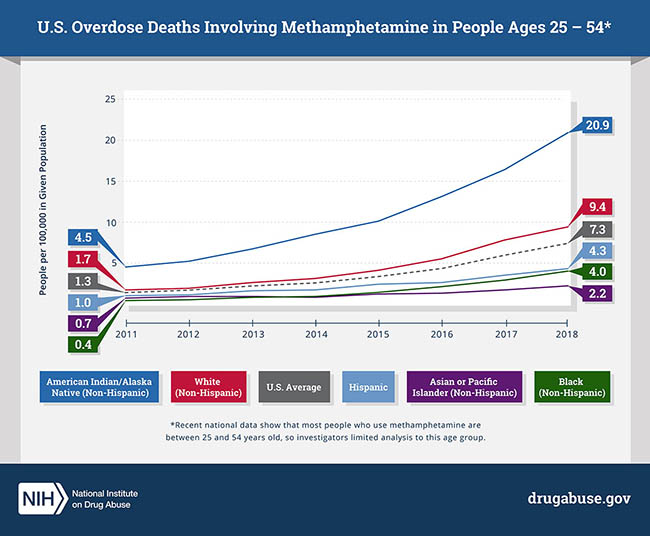Methamphetamine overdose deaths rise sharply nationwide
NIH study finds biggest increase among American Indians and Alaska Natives
Methamphetamine overdose deaths surged in an eight-year period in the United States, according to a study that will published today in JAMA Psychiatry. The analysis revealed rapid rises across all racial and ethnic groups, but American Indians and Alaska Natives had the highest death rates overall. The research was conducted at the National Institute on Drug Abuse (NIDA), part of the National Institutes of Health.
Deaths involving methamphetamines more than quadrupled among non-Hispanic American Indians and Alaska Natives from 2011-2018 (from 4.5 to 20.9 per 100,000 people) overall, with sharp increases for both men (from 5.6 to 26.4 per 100,000 from 2011-2018) and women (from 3.6 to 15.6 per 100,000 from 2012-2018) in that group. The findings highlight the urgent need to develop culturally tailored, gender-specific prevention and treatment strategies for methamphetamine use disorder to meet the unique needs of those who are most vulnerable to the growing overdose crisis. Long-term decreased access to education, high rates of poverty and discrimination in the delivery of health services are among factors thought to contribute to health disparities for American Indians and Alaska Natives.
“While much attention is focused on the opioid crisis, a methamphetamine crisis has been quietly, but actively, gaining steam—particularly among American Indians and Alaska Natives, who are disproportionately affected by a number of health conditions,” said Nora D. Volkow, M.D., NIDA director and a senior author of the study. “American Indian and Alaska Native populations experience structural disadvantages but have cultural strengths that can be leveraged to prevent methamphetamine use and improve health outcomes for those living with addiction.”

Non-Hispanic American Indians and Alaska Natives: Overdose deaths involving methamphetamine rose from 4.5 to 20.9 per 100,000 people ages 25 to 54 during 2011-2018.
This page was last updated on Friday, January 21, 2022